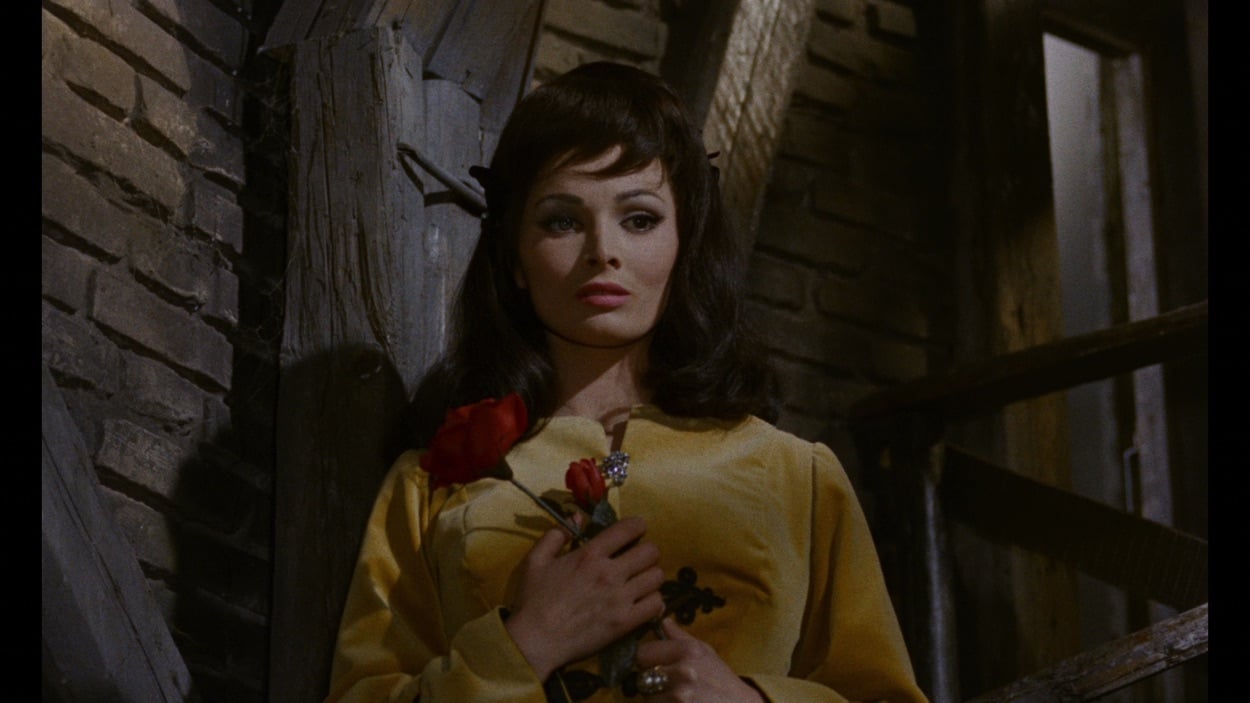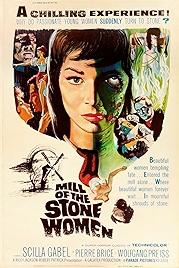1960’s Mill of the Stone Women was the first Italian horror film to be shot in colour – Technicolor, no less – and is a landmark film which opened the door to the lurid looks and titillating scenarios of the giallo genre.
Also known as Drops of Blood (or Il mulino delle donne di pietra, in the original Italian), but not in the slightest bit frightening no matter what you call it, it’s soaked in atmosphere only enhanced by the dislocating effect of the foreign language dubbing.
It’s dubbed no matter which language you watch it in – originally it came in German, French, Italian and two different English dubs (one more US, the other more UK in accent). The star, Pierre Brice, spoke his lines in French throughout, while most of the other actors were speaking Italian, so there’s no such thing as a version in the “original” language, in case you’re after authenticity. That said, the dubbing on the Italian and French versions is better integrated with the ambient sound and they’re the ones to go for it you’re after a more comfortable aural experience.
Brice plays Hans, the professorial assistant who’s turned up at the windmill home of sculptor Professor Gregorius Wahl to help write a monograph celebrating the centenary of the old building and its curious exhibition room where life-sized female mannequins from history (Joan of Arc, Cleopatra etc) turn on a carousel when the windmill’s machinery is engaged. Wahl doesn’t just work there, he also teaches art there, to the sort of way-too-old young people who tend to populate films of this era.
The professor has a mysterious daughter, Elfie (Scilla Gabel), whose heaving bosom catches the eye of Hans, and the she’s attended by Bohlem (Wolfgang Preiss), a live-in doctor who’s got a serious middle-aged crush on the young Elfie.
A cross between a Mexican standoff and a love triangle develops between Elfie, Hans and Bohlem, and once Hans’s childhood sweetheart, Liselotte (Dany Carrel), is thrown into the mix – she happens to be one of the professor’s students – it turns into an awkward love quadrilateral.
The story is by Pieter Weigen, say the credits, but there was no such person. He’s a fictional creation designed to gloss the fact that this is a creature created from various bits of Frankenstein and Dracula. The desire to be evasive also explains the presence of not one but two learned men – the professor and the doctor. Neither character has enough to do on his own and on the rare occasion when both men are in the scene it’s a bit like seeing double. For reasons of economy it would have made sense to combine them, but that would make the comparison with, say, The Bride of Frankenstein even more obvious.
That said, the dark-haired Elfie, with a tweak, is a vampire – she’s a lusty woman with a strange, blood-based medical condition which does not allow her to live “like other girls”, while Liselotte tweaked would make a fine sacrificial Mina (from Dracula) and Hans is a stand-in for the naive Jonathan Harker.
The flat wintry expanses of the Netherlands deliver bleak, misty exteriors, though apart from a couple of scene-setting moments out on the waterways, the bulk of the action takes place on studio sets. Here we’re either in plush Hammer Horror-style Victorian rooms, all swagged and draped, or in the mill, where a more starkly angular, slightly expressionistic look echoes the mill where 1931’s Frankenstein climaxes.
The woman whose passions are dangerous, the smooth controlling father, the diabolical doctor, the naive ingenue, a mystery illness, it’s all very gothic but in a way that’s more Wilkie Collins than Bram Stoker. Moody rather than scary.
Director Giorgio Ferroni, DP Pier Ludovici Pavoni and composer Carlo Innocenzi assemble all the bits like the professionals they are. This is a film that works, though the tendency in some quarters to lump Mill of the Stone Women in with the other big horror films of 1960 – Psycho, Peeping Tom, Eyes without a Face – is too much of a stretch.
I didn’t watch the new 2K restoration released by Arrow in the UK (Mondo Macabre in the USA). I wish I had. The old version I saw had pretty good picture quality, but the colour was strobing here and there. Since Technicolor usually buffs up remarkably well, I’d be surprised if the new version wasn’t a vast improvement. Another word on old versions – if your Mill of the Stone Women is not 95 minutes long, you’ve probably been denied the much-discussed “nipple shot”. Oooh. Go with the new one, in other words. It’s what I’m linking to below.
Mill of the Stone Women – Watch /buy the restored version at Amazon
I am an Amazon affiliate
© Steve Morrissey 2021


